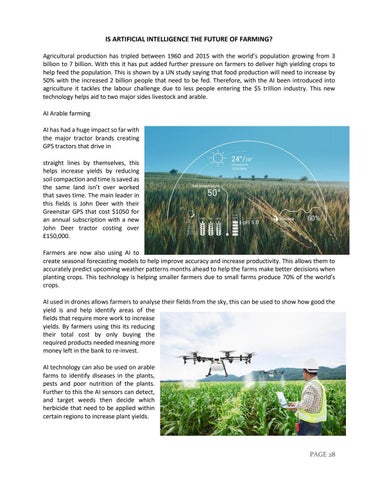IS ARTIFICIAL INTELLIGENCE THE FUTURE OF FARMING? Agricultural production has tripled between 1960 and 2015 with the world’s population growing from 3 billion to 7 billion. With this it has put added further pressure on farmers to deliver high yielding crops to help feed the population. This is shown by a UN study saying that food production will need to increase by 50% with the increased 2 billion people that need to be fed. Therefore, with the AI been introduced into agriculture it tackles the labour challenge due to less people entering the $5 trillion industry. This new technology helps aid to two major sides livestock and arable. AI Arable farming AI has had a huge impact so far with the major tractor brands creating GPS tractors that drive in straight lines by themselves, this helps increase yields by reducing soil compaction and time is saved as the same land isn’t over worked that saves time. The main leader in this fields is John Deer with their Greenstar GPS that cost $1050 for an annual subscription with a new John Deer tractor costing over £150,000. Farmers are now also using AI to create seasonal forecasting models to help improve accuracy and increase productivity. This allows them to accurately predict upcoming weather patterns months ahead to help the farms make better decisions when planting crops. This technology is helping smaller farmers due to small farms produce 70% of the world’s crops. AI used in drones allows farmers to analyse their fields from the sky, this can be used to show how good the yield is and help identify areas of the fields that require more work to increase yields. By farmers using this its reducing their total cost by only buying the required products needed meaning more money left in the bank to re-invest. AI technology can also be used on arable farms to identify diseases in the plants, pests and poor nutrition of the plants. Further to this the AI sensors can detect, and target weeds then decide which herbicide that need to be applied within certain regions to increase plant yields.
PAGE 28








































